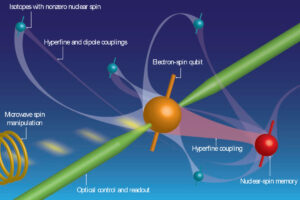
Spintronics, short for “spin transport electronics,” is an emerging field in nanotechnology and solid-state physics that explores the use of an electron’s intrinsic spin, in addition to its charge, to transmit, process, and store information. The spin of an electron is a fundamental quantum property that can be described as an “up” or “down” state, representing a binary bit of information (0 or 1).

Here are some key concepts and components in spintronics:
Spin-polarized current: In spintronics, the goal is to generate and control a current of electrons with a specific spin orientation, called spin-polarized current. This is achieved using materials with magnetic properties, such as ferromagnets, which can selectively align electron spins in a specific direction.
Giant Magnetoresistance (GMR): The discovery of GMR in 1988 by Albert Fert and Peter Grünberg played a crucial role in the development of spintronics. GMR is a phenomenon in which the electrical resistance of a multilayered material (typically composed of alternating ferromagnetic and non-magnetic layers) varies significantly under the influence of an external magnetic field. This property has been used to develop highly sensitive magnetic field sensors and revolutionized the read heads in hard disk drives.
Tunnel Magnetoresistance (TMR): TMR is another key effect in spintronics, observed when electrons tunnel through an insulating barrier between two ferromagnetic layers. The tunneling current depends on the relative alignment of the magnetization in the two layers, which in turn affects the electrical resistance. TMR has been used to develop magnetic random-access memory (MRAM), a non-volatile memory technology with fast read/write speeds and low power consumption.
Spin-transfer torque (STT): In spintronics, controlling the magnetic state of a material is essential. STT is a phenomenon where a spin-polarized current can change the magnetic orientation of a nanoscale magnetic element by transferring its spin angular momentum. This effect is used in STT-MRAM devices, which offer improved energy efficiency compared to traditional MRAM.
Spintronics devices: Besides MRAM, spintronics has potential applications in various devices, such as spin transistors, spin-based logic gates, spin-based oscillators, and spintronic solar cells. These devices could offer improved performance, power efficiency, and novel functionalities compared to their charge-based counterparts.
Topological insulators: These are materials that act as insulators in their bulk but have conductive surface states. In these materials, the spin of the electrons is locked to their momentum, offering unique opportunities for spin manipulation and transport with minimal energy loss.
Spintronics has the potential to revolutionize electronics by enabling devices with lower power consumption, higher data storage density, and novel functionalities. However, challenges remain in developing materials and techniques for efficient spin generation, manipulation, and detection at room temperature. Continued research and development are needed to fully realize the potential of spintronics in practical applications.